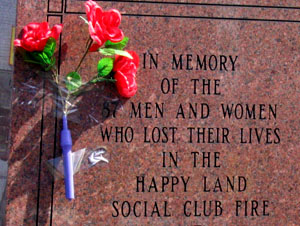Este artículo también está disponible en: Español
March 2007
- A memorial to the victims of a 1990 fire in the South Bronx. (Photo: Diego Graglia)
A lethal fire in a Bronx building last week brought back two words to the city’s collective consciousness: Happy Land.
At home near Orlando, Rubén Valladarez saw the fire on the morning news. What a coincidence, he told me that evening over the phone, that a big fire would happen around this date.
Valladarez is one person who doesn’t need reminders of the Happy Land Social Club massacre, where 87 partygoers died in 1990 when a club employee’s ex boyfriend set the place on fire. March 25, a week from Sunday, will mark the 17th anniversary of that tragedy, the biggest New York had seen in 79 years.
Valladarez was the DJ that night, and one of two people who escaped the club’s second-floor death trap.
Yelling, “Those who want to live, follow me!” Valladarez dashed downstairs through flames to reach the sidewalk, suffering serious burns that scarred him for life.
“The desire to live pushed me through the flames,” he once told me. “While I was running, the only thing I felt was my body was falling apart.”
Nightmares still visit him today. “I don’t think it will ever go away,” he said.
Like the High Bridge tragedy did to Malians, Happy Land devastated one small, little-known immigrant group. The majority of those dead were Garífunas, descendants of Africans who intermarried with Caribbean tribes in the 17th century.
“Our people went to that [club] a lot,” says Rejil Solís, the president of Garífuna Coalition USA. At least 50 of those dead were Honduran Garífunas, he adds.
While Happy Land has become a faded memory for many, among Garífunas March 25 remains a black circle in the calendar.
“Those who were not there remember what they were doing that morning,” says Mirtha Colón, president of Hondurans Against AIDS. “I remember the first call I received at 5 a.m.”
The date is also a reminder that city and Bronx officials haven’t followed through on their promise to build a community center where people would have fun safely, says Honduran consul Javier Hernández Mejía.
As every year, there will be a Mass for the victims at 12:30 p.m. at St. Thomas Aquinas Church, 1900 Crotona Parkway. Families will then place flowers at the brown marble obelisk that honors those lost, across the street from where the club was.
Unfortunately, Garífunas say, the media seek them only when the news is bad. After Happy Land there was Hurricane Mitch, which ravaged their Central American hometowns in ’98. Last year, a community organizer was charged in an immigration fraud case.
But Garífunas –who come from the Caribbean coast of Honduras, Belize, Guatemala and Nicaragua– have been New Yorkers since the 1930s, when a few merchant sailors decided to stay here, according to Solís. Today they are concentrated in the South Bronx and Eastern Brooklyn. Estimates put their numbers from the low to the high tens of thousands.
Valladarez, who left New York in 1992, visited his siblings in January. As every time he’s in town, he stopped by the obelisk. He brought flowers for the victims, he cried a little. He thought of José Alvarez, his grade school buddy in Honduras, his eldest daughter’s godfather.
“When the fire started, he was standing right beside me,” Valladarez said. “Then the lights went out and I lost sight of him.”
 Every-Night Fever at the Milonga (2007)
Every-Night Fever at the Milonga (2007)  Migrants Suffer in Mexico (2006)
Migrants Suffer in Mexico (2006)  Leaving Wall Street (2006)
Leaving Wall Street (2006)  Torn Up Over Being Torn Down (2004)
Torn Up Over Being Torn Down (2004) 


